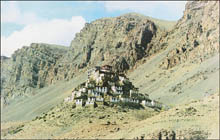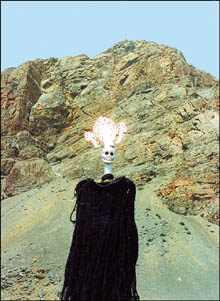




















 

 |
God of Ki
By Arun Gaur
ON the road to Ki, our scooter
pants again and shrieks again. But we know, we would make
it. Both the vehicles and the riders are experienced
enough. They shriek, but they make it. We have petrol,
and moreover our engine turns! Moreover, my young
companion is the greatest assuring factor — his
weightlessness, his manoeuverability, mental as well as
physical, his navigating intuitions, his telescopic eyes,
his composed ascending of steep slopes with both hands
languidly resting in his jacket pockets, brim of his cap
drooping over his eyes nonchalantly, and above all his
culinary skills. As we gather height, towards the 4,000
metre mark, at first gear, our scooter roars, thumps, and
irregularly pulsates.
 We bend down as much as possible over it,
trying to lower our centre of mass for optimum stability
and streamline the system to have the least possible
aerial resistance. We give it a wider arch at every turn,
as much wide as possible on that narrow strip of
unmetalled road and then finally reach the gateway of the
Ki monastery. We bend down as much as possible over it,
trying to lower our centre of mass for optimum stability
and streamline the system to have the least possible
aerial resistance. We give it a wider arch at every turn,
as much wide as possible on that narrow strip of
unmetalled road and then finally reach the gateway of the
Ki monastery.
It is a pyramid —
its faces studded with white cells. At a specific
distance, the impression is of Ki as a small but
formidable fortress. As we approach the monastery, its
impregnable appearance becomes less acute. Undoubtedly,
in the past it was not as porous as it appears today from
close quarters. At that time it had to act as a real
fortress, defending itself against the forces that
emanated not only from the principalities that lay in the
still higher Tibetan terrain but from the lower plains
too. As a fortress should be, it is eminently positioned,
some say, on an extinct volcano, and strategically
commands a view of the country before it. Its back is
defended by the steep rocks from the human aggressors as
well as from the violence of winds.
From the monastery, we
can see the wide bed of emerald Spiti divided into many
channels. Mostly, it is dry and gleams like silver. On
the other bank, there are clusters of prodominantly
white, box -like houses at one or two places with
overhanging steep pale cliffs and the snow-line. Seldom
does one find a settlement on the other side of the
river. The right bank, particularly from Tabo to its
confluence with Satluj at Khab, doesn’t offer enough
of the level ground to permit any clustered habitation.
Immediately below, there is a huge stretch of level arid
soil, and the bridle-paths run across them. On the edge
of this vast wasteland of the cold desert. There are a
few rare cultivated patches, dark green and black.
 Though this ancient Ge-lug-pa
monastery — possibly its roots go to the 11th
century — has been repeatedly assaulted, surprise
has often been expressed if it was worthwhile to annex
such a territory. Besides its stark beauty, what could
these arid, rugged deserts offer to the conquering
armies? To their best, monasteries like Ki resisted, and
whenever the plunderers did overcome them, they retreated
with the plunder to their native lands. But many did not
go back. Particularly those, who came from the higher
reaches like Ladakh or Tibet could easily settle here.
These new settlements did affect the iconography and Lama
system of the monasteries. Though this ancient Ge-lug-pa
monastery — possibly its roots go to the 11th
century — has been repeatedly assaulted, surprise
has often been expressed if it was worthwhile to annex
such a territory. Besides its stark beauty, what could
these arid, rugged deserts offer to the conquering
armies? To their best, monasteries like Ki resisted, and
whenever the plunderers did overcome them, they retreated
with the plunder to their native lands. But many did not
go back. Particularly those, who came from the higher
reaches like Ladakh or Tibet could easily settle here.
These new settlements did affect the iconography and Lama
system of the monasteries.
Monasteries like Ki, in
the past, were not as secluded or isolated as they appear
today perched on the rock-heads. The dwellers of these
cells were drawn from every family of the villages
scattered around. Usually in one cell, the full-fledged
uncle-monk received, under his tutelage, his own young
nephew who had just been initiated into monastic life.
The monks received their share of the family income,
offered their services to the village folk on every
important occasion and even indulged in economic
transactions and scholastic activities.
These monks became
experts in magic and could pin-point the stealers,
sending shudders down the spines of many violators of law
in the comparative warmth of the spring season, they
remained busy among the inhabitants of villages, and when
the snow came, they locked themselves up in the monastery
that had enough supply of food and wood for fire. While
the snow gnashed and clattered its teeth all around, they
churned their salted butter tea with a divine rhythm and
waited patiently for the turn of the season.
On the roof of the
top-most cell, grin the demonic deities as the tufts of
coloured flags wrapped round poles quiver. Silvery white
skulls, red-eyed, golden crowned, with flowing strands of
black apparel stirring down their scrawny necks in the
forenoon deceptively composed puffs of wind restraining
its fury yet. These deities and the narratives woven in
the thankas of the dim rooms fly in the face of
positive gods. 
|

